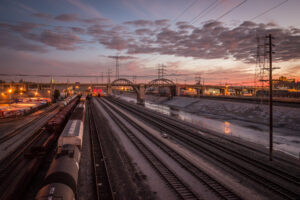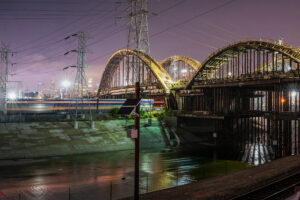OF THE 6TH STREET BRIDGE
At the center of Los Angeles lives the Sixth Street Bridge, also known more formally as the Sixth Street Viaduct. It was constructed in 1932 as part of a group of 10 bridges designed to cross the Los Angeles River.
Then Chief City Engineer Merrill Butler oversaw his “City Beautiful” movement creating 10 unique bridges to be erected during the 20’s and 30’s. The Bridges were to “reflect the cultural history of Los Angeles, incorporate varied themes to resonate with those cultures, and connect the downtown Los Angeles area with the expanding areas and neighborhoods east of the Los Angeles River.”
Architect Louis Huot designed the 6th Street bridge to be the most modern of the 10 dubbing it “Streamline Moderne” with an Art Deco influence to its structure, lines, and architectural embellishments. The Sixth Street Bridge serves to connect the Los Angeles Arts District and the vibrant community of Boyle Heights. In 1932, nine years after its completion, the Los Angeles River was channelized and covered over in concrete to address Governmental concerns regarding the control and prevent erosion due to flooding. Environmentalists have continued to warn that the concrete removal of the channel must be completed in order to allow the LA River to develop as a true water channel and water source for Southern California.
About 20 years after completion, the 6th Street Bridge began showing signs of Alkali-Silica Reaction or ASR. ASR is a chemical reaction that causes cured cement to slowly disintegrate when seeping rainwater infiltrates it creating long-term and ongoing instability. It was also less formally dubbed “concrete cancer”.
Multiple efforts to correct the deterioration issues proved unsuccessful in stopping the continued chemical corrosion of the concrete. Numerous community leaders in the Arts District fought to find a solution other than taking down the bridge. Studies were created and engineers engaged. The City opted to pursue a 500 million dollar federal grant to redesign and rebuild the bridge. A report was created called 6th Street Viaduct Seismic Improvement Project published in October 2011 by the City of Los Angeles and the California Department of Transportation. Despite a 1968 Caltrans survey that deemed the Sixth Street Viaduct as eligible to qualify for the National Registry of Historic Places, its status as a Historic-Cultural Monument, and efforts by the Los Angeles Conservancy to protect the bridge, the 2011 report determined
that the Sixth Street Viaduct needed to be demolished and replaced. The report was the ultimate death knell of the original bridge.
The Communities of the Arts District and Boyle Heights attended numerous planning meetings and engaged in rigorous debate as to who should represent the interests of the two communities. The replacement bridge architect selected was architect Michael Maltzan and the HNTB Design-Build team, as it is the only design that integrated a public park and plaza underneath the bridge.
The 6th Street Bridge continues to be an icon for our communities both yesterday’s and today’s iteration. Bridgefest is a celebration of OUR bridge, our perseverance, and our love of public spaces.
WELCOME TO YOUR NEW WORLD,
6TH STREET BRIDGE
We are excited to present this online show of the works of nationally renowned photographer Fred Hoerr.
Having grown up in a family constantly on the move throughout the midwest and the southern United States, the changing social and physical environments fostered a very solitary view of reality, as if through a viewfinder. Long before picking up a camera, Fred initially used his photos as reference for painting and to be layered for screenprints. More recently, Fred began shooting purely for the sake of photography.
A longtime resident of downtown Los Angeles, Fred’s first and ongoing project, Riversystem, combines landscapes, portraits, and detail from along the Los Angeles River and some of the people living in and around its structures and the bordering Union Pacific rail lines. Having lived near the river for years, the spaces served as his backyard and wilderness. Fred was initially inspired by its raw beauty, working to describe its grand vistas and skylines framed by the people sharing its space.
Fred’s work in and around the neighborhood is profound and he has revealed himself to be one of the great “cataloguers” of our precious LA History.
We are grateful and honored to be allowed to share his spectacular images,
THE PAST
THE PAST | THE PRESENT
|

